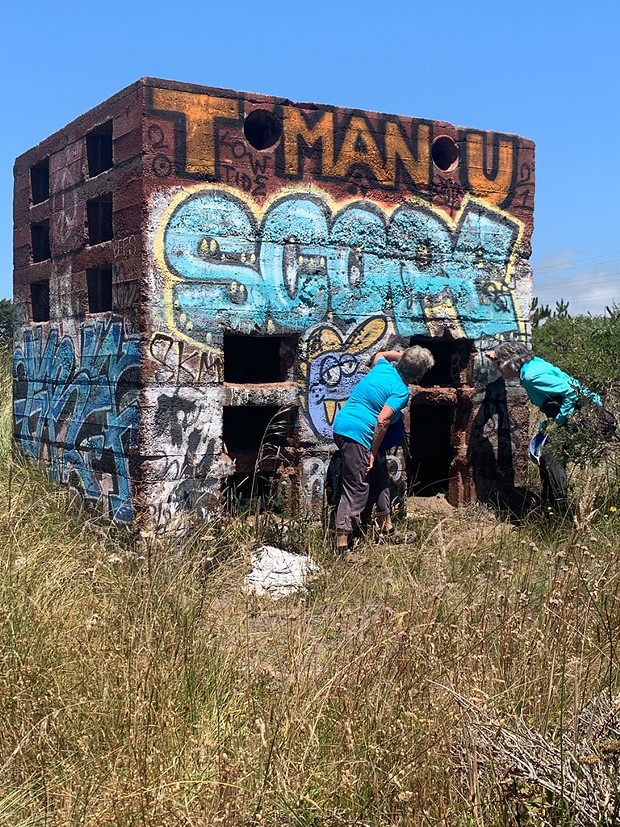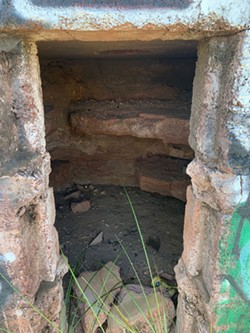
Something was happening here during the brief life of the smelter, 1958-'59. But what exactly, I'm not sure we'll ever know.
[
{
"name": "Top Stories Video Pair",
"insertPoint": "7",
"component": "17087298",
"parentWrapperClass": "fdn-ads-inline-content-block",
"requiredCountToDisplay": "1"
}
]
A memo from the Environmental Protection Agency dated Aug. 18, 2003, stating that clean-up work at a 3-acre Superfund Site on the Hoopa Reservation was complete, included this curious phrase: "The ore concentrates were trucked off-site for further processing." It's curious because, having listed contaminants resulting from two years of work extracting copper and zinc from a nearby mine, you might think the EPA would be concerned exactly what concentrates were shipped off. And to where? Especially because the plant, known as the Celtor Chemical Works Mine, was known to have sent lethal contaminants into the Trinity River below the site, resulting in numerous fish kills.
Turns out those ore concentrates were shipped to the Samoa Peninsula to further extract "H iron," along with cobalt, nickel and other metals, according to an interview with the site's promoter, Carmelo Charles Celestri, M.D. (printed in the now defunct Arcata Union on Aug. 8, 1958). Celestri is quoted saying, "Our chemical processes make it possible to utilize every kind of mineral in ore .... There will be no waste [or] fumes." According to the story, "in four years' time, a payroll of 3,000 people is expected."
Do we, as a county, attract more scam artists than other parts of the world? Shouldn't that improbable "3,000 people" have been a tip-off? Or the introduction of the mysterious "H iron" (reminding me of the MacGuffin, "unobtainium," that drove the plot in the 2009 hit movie Avatar ("Unobtanium, the Ultimate MacGuffin?" June 10, 2010). Within two years, the Hoopa plant had apparently gone bust after Celestri stopped payments to the tribe for the lease. And two years later, the site was abandoned, leaving a witch's brew of contaminants — arsenic, copper, cadmium and lead — resulting in the area being designated a Superfund Site in the 1980s. In 1995, the state sued Celestri for clean-up costs but I've been unable so far to find the result of that action.
After years of decontamination, the site was designated "clean" in 2003, according to the EPA memo referenced above. Except it wasn't. In 2016, more heavy metals were found in the old mine tailings, and as of 2019, the site is back on the Superfund program for further decontamination.
So what happened to the ore shipped to the Samoa Peninsula for Celestri's "further refinement?" According to the 1958 interview with Celestri, "The process, basically, revolves around the making of milk of magnesia from sea water, and employing it chemically to extract mineral from ore. We chose the [Samoa] location of the plant for two reasons: plenty of available wood waste and the availability of sea water." By the following July, the plant was idle, according to an EPA memo. Was the whole venture a scam to attract investors? Looking at the site now, you can see signs of a kiln or oven in the interior, so someone was heating something during the few months the smelter (if that's what it was) actually smelted.
It all sounds pretty sketchy to this skeptic. I'm hoping old-timers reading this might have some knowledge of the project. How was the set-up actually used? Is the site still contaminated? And what eventually happened to the doctor who may have managed to hustle a bunch of Humboldt folk some 60 years ago?
Barry Evans (he/him, [email protected]) notes that the first chemists were alchemists, trying to turn lead into gold.
Speaking of...
Comments (2)
Showing 1-2 of 2
more from the author
-
Doubting Shakespeare, Part 1: Stratfordians vs. anti-Stratfordians
- Apr 25, 2024
-
A Brief History of Dildos
- Apr 11, 2024
-
Eclipse!
- Mar 28, 2024
- More »
Latest in Field Notes
Readers also liked…
-
Trouble on the Line: The Reality Part 2
- Nov 3, 2022


































